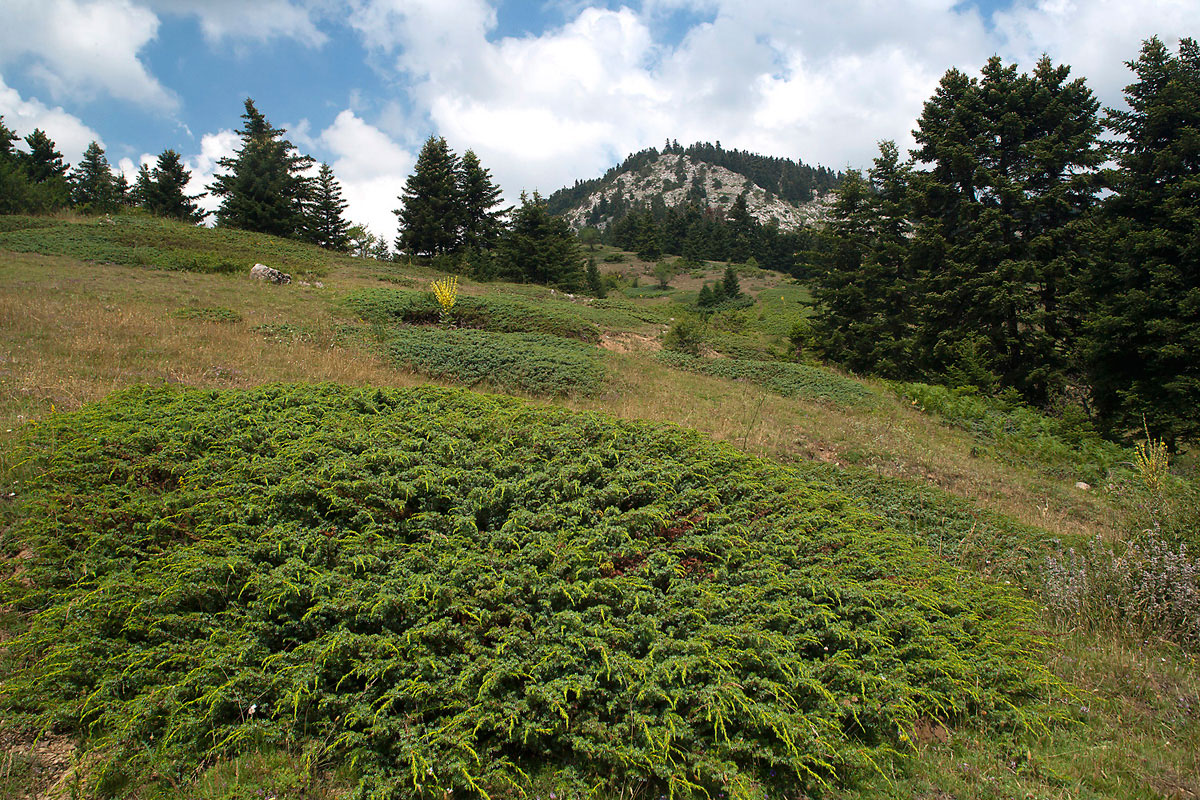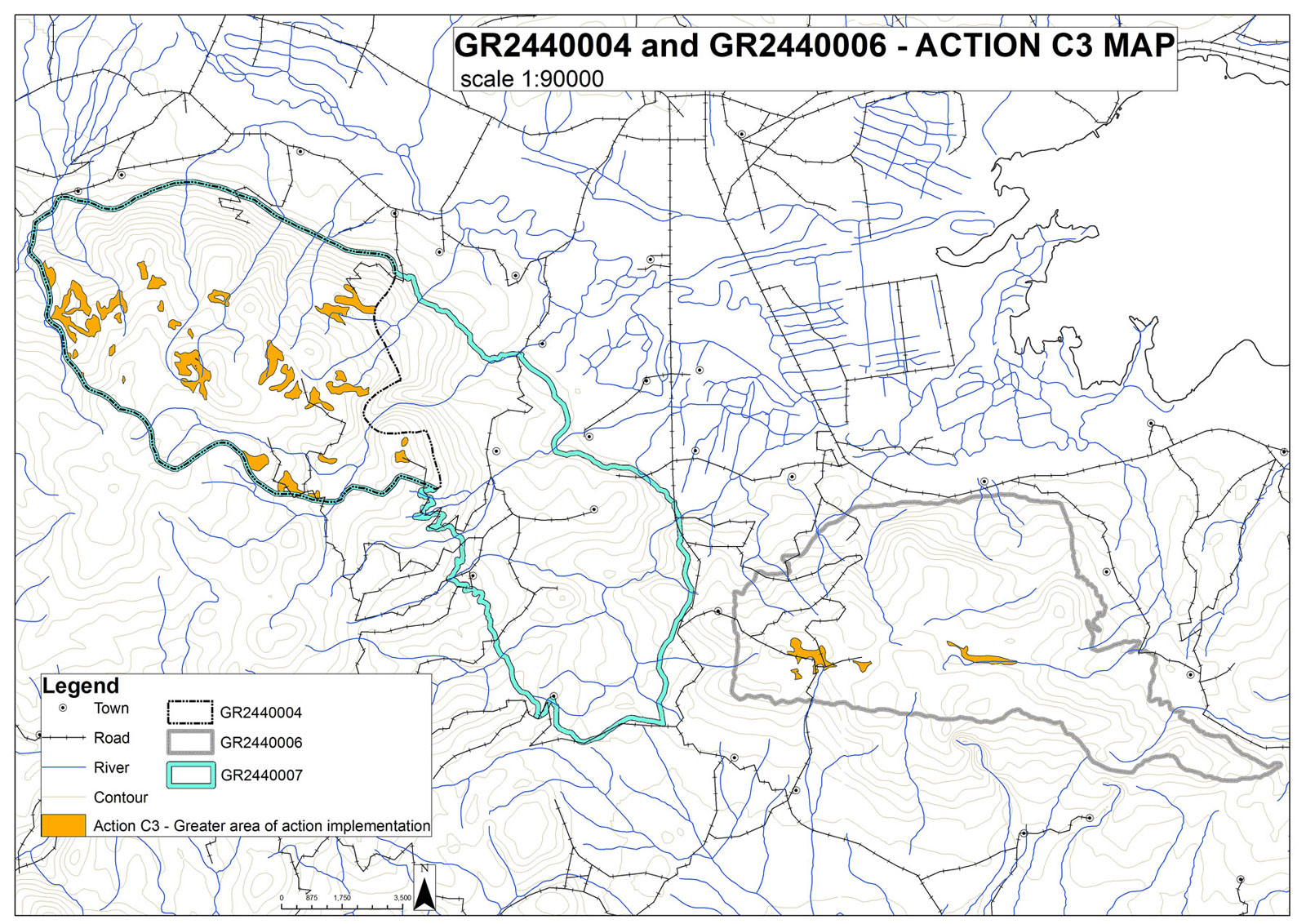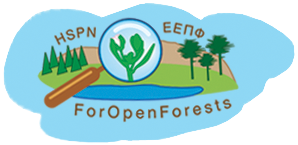Main menu
Conservation of priority forests and forest openings in "Ethnikos Drymos Oitis" and "Oros Kallidromo" of Sterea Ellada, LIFE11 NAT/GR/1014
Actions
Action C.3: Grazing management and woody vegetation clearing for the restoration of temporary ponds (3170*) and mountain grasslands (6210*, 6230*)

The purpose of this action is to restore biodiversity and ecosystem function of mountain grasslands (6210*, 6230*) and of the temporary ponds (3170*) by management interventions that were traditionally applied in these habitats, i.e. regulation of grazing and shrub clearing.
This is a pilot action, during which various management regimes will be applied for 3–4 consecutive years in order to determine the regimes that favour the target habitats. The general scheme for the management regimes to be applied is described below, but the detailed design will be made according to the specifications of action A.6. The locations of action C.3 cannot be foreseen accurately, since they will be specified by the results of actions A.1 and A6. Nevertheless, all parts of this action will take place within the boundaries of the sites GR2440004 and GR2440006 (see map with indicative locations).
Mountain grasslands (6210*, 6230*):
- In each of the two Natura 2000 sites on Mts. Oiti and Kallidromo, three intervention sites of 10–40 ha (10,000– 40,000 m2) will be selected so that they represent three existing grazing regimes (as determined by action A.6), with stocking rates corresponding to moderate grazing (at the level of grazing capacity), heavy grazing (twice the level of grazing capacity) and control (no grazing). Heavy grazing, i.e. grazing that exceeds the grazing capacity, is not identical to overgrazing. Overgrazing refers to continued heavy grazing that exceeds the recovery capacity of a plant community. Heavy grazing favours certain species (e.g., annual legumes and frugivorous birds). It should be noted that these are controversial subjects, both in the scientific community and among land managers. The intention of the proposed treatment is to find the optimal regime for the conservation of grassland biodiversity without prejudice about what is “good” or “bad”. Were it known a priori that heavy grazing is bad and no grazing unfavourable for the priority habitats, moderate grazing would have been prescribed and no treatment testing would have been necessary.
- Control of thistles and excess of biomass (including hard grasses) by mechanical method (mower) will be applied to approximately half the area of the intervention sites. Mowing is needed annually, and is expected to be done 3 times in the period of the project. A surface area of a total of 80 ha in both the project sites will be treated 3 times.
- Control of shrubs (mainly Juniperus nana) by manual cutting or burning will be applied as necessary (shrub encroachment is generally observed in approximately one fourth of the area covered by grasslands). Shrub clearing is generally needed every 3 years, and we expect to carry it out once in the period of the project. A surface area of a total of 40 ha in both the project sites will be treated once.
- In addition, 5–10 mobile wooden cages covering an area of 2–3 m2 and preventing grazing will be placed in each grazing x thistle and shrub control combination.
Temporary ponds (3170*):
- In each of the seven ponds of Mts. Oiti and Kallidromo, intervention sites of approximately one third or half of the pond area will be fenced by non-permanent metallic pole fences and banned to grazing. This fencing will be additional to, and combined with the fencing of action C.1. Control of helophytes or grasses will be made through action C.4, as necessary. Control of shrubs coincides with the control of shrub encroachment applied for the grasslands, since the ponds are located within the grasslands.
The daily activity of the cattle on Mt. Kallidromo will be monitored by GPSR tracking ringers attached to 10 animals. The activity of the sheep and goat herds both on Mt. Oiti and Mt. Kallidromo can be monitored in cooperation with the shepherds. The impact of all the management regimes will be evaluated by actions D.1 and D.2, and amendments will be made if necessary. The evaluation of cattle patterns in the areas, in combination with the evaluation of the impact of management will be used in order to make proposals for after-LIFE long-term management (actions D.1 and D.2) and to produce the manual for grazing and woody vegetation management for the conservation of grasslands and temporary ponds.
The main guarantee for the after-LIFE application of the optimum management regimes is the set of actions targeted to stakeholders. Also, the RST Forestry Service and the Management Body are expected to promote the application of the regimes prescribed by the project results.
Preliminary contacts with local stockbreeders on Mt. Kallidromo indicated that, at least some of them, especially the younger ones, would be willing to co-operate. They attached great importance to: a) current prohibitions of grazing imposed by the RST Forestry Service which they believe are not justified in certain habitats; and b) the inadequate social and economic status of animal farmers in combination with the general abandonment and degradation of the rural communities. Grazing management is one of the objectives of the project and we believe that the first point can be addressed through the Stakeholder Committee in co-operation with the RST Forestry Service. The second point will be addressed by actions C.1, E.1 and E.2.
Shrub encroachment is an important threat for both the mountain grasslands (6210*, 6230*) and the temporary ponds (3170*) located within the grasslands. Shrub encroachment may be eliminated by grazing and cutting of shrubs. On the other hand, overgrazing is also a threat for both the target habitats.
The interventions proposed aim to determine the golden mean between grazing and overgrazing for habitat conservation, by applying management regimes similar to traditional practices which are currently in recession. Mountain grasslands of Mt. Oiti and Mt. Kallidromo have traditionally been part of the transhumance system applied in the region, and used as summer grazing areas for livestock, in particular sheep and goats. Shepherds with their animals used to arrive in these grasslands in April or May and depart in late October or early November. Before departing for the lowlands, shepherds used to set fires in order to control the “weeds” left after the summer grazing, so that new growth would appear in the next year when they would again visit the grasslands. During their stay in the mountain grasslands, shepherds used to cut the shrubs and branches of the trees in order to obtain firewood and construct their temporary huts to house their families who followed them in the mountains during summer. Therefore, all interventions proposed have been part of the traditional management of grasslands.
The information collected from these experimental interventions will then help designing a long-term management plan, so that the target habitats may be restored and conserved. In addition, these interventions are expected to improve the ranging condition of the grasslands, which will in turn be favourable for the economic status of the local farmers.
-
Improvement of the conservation status of the mountain grasslands and the temporary ponds of Mt. Oiti and Mt. Kallidromo. The management interventions are expected to be implemented over a total area of some 80 ha in GR2440004 and some 80 ha in GR2440006. So, within the duration of the project, these are the maximum areas where we would expect restoration.
It must be noted that currently we do not know how much of the total area of 6210* and 6230* is in need of restoration in any of the two sites. We expect that after-LIFE management with the proper regime will ensure a good conservation degree for the total area of these habitats in the project sites. In GR2440004 the total area of 6230* is estimated to be approximately 400 ha of, more or less, pure grassland and approximately 100 ha of grassland mixed with juniper shrub. In GR2440006 the total area of the grasslands may very roughly be 100 – 200 ha, but this includes all grasslands and not just 6210*.
-
A manual for grazing and woody vegetation management for the conservation of grasslands and temporary ponds based on the proposals of actions D.1 and D.2.




 news
news









